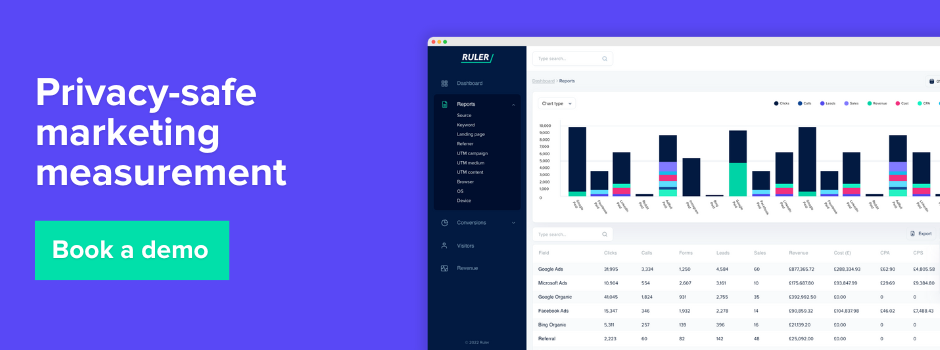The rise of privacy concerns are making cookieless tracking solutions a must-have for businesses
Digital marketers have relied heavily on third-party cookies for years.
These trackers followed users across websites, letting us tailor ads and measure campaigns.
However, privacy worries and regulations are shutting down this practice.
Browsers like Safari and Firefox restricted these cookies long ago, signalling a shift towards a web without them.
Google’s phase-out is the final blow.
Given these changes, marketers have no choice but to explore other options, and cookieless tracking solutions emerge as a crucial tool for maintaining measurement.
In this post, we dive into the best cookieless tracking solutions for 2024, giving you the tools you need to thrive in this privacy-focused era.
What we’ll cover:
💡 Pro Tip
Ruler was built on deterministic tracking that relies on first-party cookies and user identifiers, giving marketers a clear view of a user’s journey to conversion.
While this remains a core part of our product, we’ve acknowledged the escalating challenges posed by browser and privacy regulations limiting cookie and tracker usage.
In response, we’re innovating with cookieless solutions like probabilistic impression tracking and marketing mix modelling to ensure effective measurement even without cookies and unique identifiers.
Skip here to learn more about Ruler cookieless tracking solutions or book a demo to see it in action.
The buzz around cookieless tracking is hard to miss, but what exactly is it, and how does it revolutionise marketing measurement?
Cookieless tracking lives up to its name.
It’s a marketing measurement approach that ditches cookies altogether.
Unlike existing cookieless tracking systems on the market, cookieless tracking solutions take a different approach.
Take Google Analytics, for example.
By default, Google Analytics relies on first-party cookies to track and monitor user interactions.
However, cookieless tracking presents an alternative pathway.
Through methods such as server-side tracking or AI-driven machine learning, it gathers essential data points without depending on cookies.
Not only does it ensure compliance with privacy regulations, but it provides tracking in the absence of cookies.
So, why all the hype around cookieless tracking? It typically comes down to these three reasons:
Third-party cookies, the ones that are placed on your browser by websites other than the one you’re visiting, are on the chopping block.
Related: How to prepare for the death of third-party cookies
Most major browsers, including Firefox and Safari, have phased out their support for third-party cookies.
Google, in a move that sent shockwaves through the marketing world, announced the end of third-party cookies in Chrome by late 2024.
This means advertisers can no longer rely on these cookies to target ads based on your browsing history across different websites.
While third-party cookies are on their way out, first-party cookies – those placed directly by the website you visit – are still usable.
Related: Best strategies for first-party data collection
These cookies will be essential for tracking user journeys and attributing conversions and revenue to marketing long after third-party cookies retire.
But, even first-party cookies are facing tighter restrictions.
Apple’s Intelligent Tracking Prevention (ITP) significantly reduces the lifespan of first-party cookies in Safari.
These cookies can now only be stored for 1-7 days, depending on the specific settings. This means that users who return to a website after 24 hours will be treated as new visitors, making it difficult to track user behaviour over time.
Apple’s App Tracking Transparency further complicates matters.
ATT requires apps to request user permission to track their activity across other apps and websites. This “opt-in” system, a major privacy win for users, makes it much harder for marketers to gather comprehensive user data.
The combined impact of these browser and device restrictions has left traditional tracking methods on shaky ground.
We’re all aware of the demise of third-party cookies by Google Chrome and other major browsers.
But the regulations go deeper.
Regulations such as GDPR and CCPA are increasing the risk associated with using cookies, while entire nations are adopting more stringent approaches.
In countries like Denmark, Belgium, and Germany, legislation such as the Telecommunications Telemedia Data Act extends beyond third-party cookies, prohibiting the utilisation of any cookie without explicit user consent.
This shift means the data pool we depend on for targeted advertising and campaign measurement is shrinking.
Marketers who solely cling to traditional cookie-based tracking will soon be left in the dark.
While browser restrictions on cookies have grabbed headlines, it’s not just a technological hurdle.
Users themselves are becoming increasingly privacy-conscious, actively blocking trackers and making it harder than ever to reach them.
According to a February 2023 survey in the UK, around 23 percent of respondents between 45 and 54 said they reject cookies on websites daily.
This means a significant portion of your target audience is actively opting out of being tracked.
User resistance doesn’t just stop at cookies either.
Ad blockers are another weapon in their privacy arsenal. Not only do Ad blockers prevent intrusive display ads, but they also hinder the data collection practices that rely on them.
Combine these trends with stricter browser restrictions and evolving privacy regulations like GDPR and CCPA, and marketers are left with less accurate data to track and prove marketing effectiveness.
Having previously skimmed past a few tracking methods, let’s delve into the most promising solutions for cookieless tracking.
Instead of code in your browser, server-side tracking works behind the scenes. When you visit a site, your actions trigger events that are sent to the website’s server first. This server then processes the data and forwards it to analytics platforms. Think of it like this. Server-side tracking acts as a middleman, giving websites more control over the data they collect and how it’s used.
Pros of server-side tracking: Direct data capture, enhanced privacy compliance
Cons of server-sider tracking: More expensive, potential for server overload
This technique collects a bunch of seemingly minor details about your device and browser – like screen resolution, fonts, and even time zone. These details, when combined, can create a unique profile that can be used to track you across the web.
Pros of browser fingerprinting: Unique identification across sessions, no reliance on cookies
Cons of browser fingerprinting: Limited accuracy, ethical and legal issues
Similar to browser fingerprinting, device fingerprinting generates a unique identifier based on the characteristics of the user’s device. From hardware specifications to software configurations, this method offers a granular understanding of user behaviour across devices.
Pros of device fingerprinting: Enhanced security, cross device tracking
Cons of device fingerprinting: Inconsistent data across devices, ethical and legal issues
Instead of using user identifiers, probabilistic tracking uses statistical models and machine learning to estimate the likelihood of each touchpoint influencing a conversion or revenue.
Related: What is probabilistic attribution and its impact on marketing measurement?
Ruler’s probabilistic attribution, for example, takes clicks, cost, impression and user-level signals from all your ad platforms to create a holistic and unbiased report that shows the true impact of your campaigns. Skip to learn more about Ruler.
Pros of probabilistic tracking: Acknowledges influence of upper-funnel channels, shows provides attribution without massive data collection
Cons of probabilistic tracking: Relies on assumptions, less precise than deterministic methods
A traditional yet enduring method, MMM quantifies the impact of various marketing initiatives on business outcomes. By analysing historical data and external factors, MMM enables marketers to optimise their strategies across channels, regardless of cookie availability.
Related: What is marketing mix modeling? The future of measurement
Pros of MMM: Quantifies everything, measures offline media channels
Cons of MMM: Time-consuming to build, often complex
Now that we’ve addressed the limitations of tracking due to browser restrictions and regulations, let’s explore some power tools that empower you to effectively measure marketing success without relying on cookies.
Ruler provides a strong attribution solution for businesses to understand their marketing impact.
We traditionally used deterministic tracking, which relies on user IDs and first-party cookies.
By tracking click-path journeys through these identifiers, marketers can learn which channels, ads, keywords and pages attract their best leads and customers.
Related: How to view full customer journeys with Ruler
While this approach remains fundamental to Ruler’s capabilities, we’ve acknowledged the escalating challenges posed by browser and privacy regulations limiting cookie and tracker usage.
In response, we’ve introduced innovative cookieless tracking solutions such as probabilistic impression tracking and MMM, allowing marketers to maintain marketing measurement in the absence of cookies and unique identifiers.
Let’s break it down:
Ruler’s probabilistic tracking leverages a machine learning-based Bayesian statistics model.
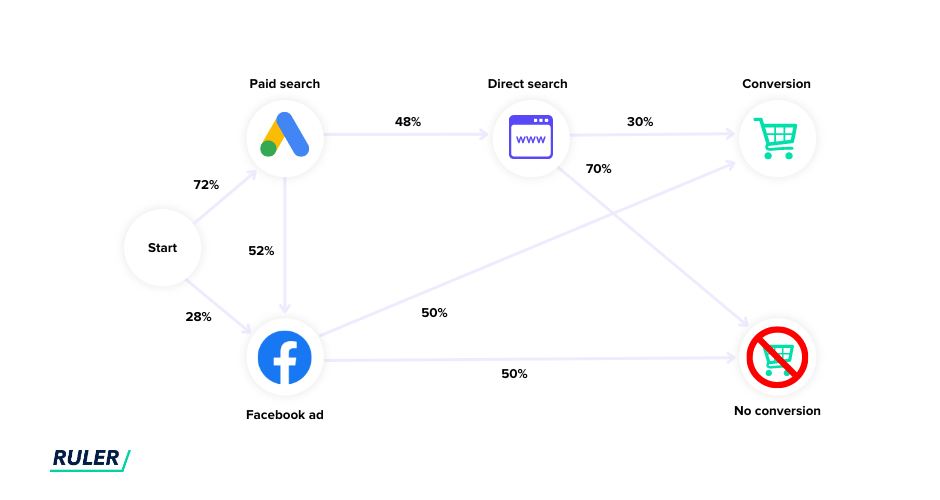
This approach utilises sophisticated algorithms to analyse user behaviour and match ad impressions to eventual conversions and revenue generation.
When robust models like MMM are available, Ruler integrates their outputs to assign weights to different marketing channels based on their contribution.
In cases where MMM data isn’t available, Ruler uses alternative signals to make these determinations.
This might include click-through rates, impression volumes, and other user-level data points.
Once impressions are matched to conversions, Ruler employs Shapley Regression, a game theory framework, to fairly distribute credit across the marketing channels involved.
Ruler’s MMM is a statistical modelling technique that utilises machine learning to quantify the impact of various marketing channels on a business’s key metrics.
For instance, MMM can reveal how ad spend or impressions contribute to sales or other target variables.
Unlike multi-touch attribution, which focuses on click path data, MMM considers both online and offline touchpoints, including impressions from TV, radio, or other channels that lack click-through data.
Combining deterministic tracking with probabilistic impression modelling and MMM provides a more complete picture of how marketing influences revenue and ROI, ensuring credit is distributed fairly to all channels throughout the entire funnel.
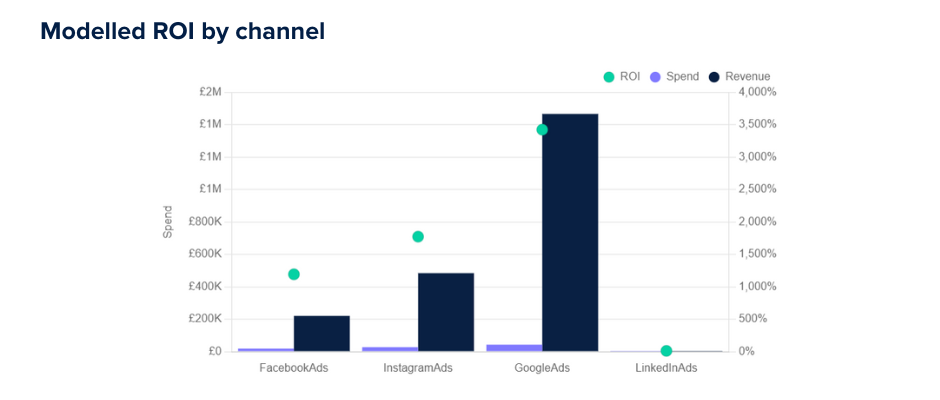
Pricing for Ruler starts at £199 a month. You can save 20% by paying annually and there are also discounted rates for agency partners.
💡 Pro tip: Interested in seeing how Ruler seamlessly integrates deterministic and probabilistic data? Schedule a demo to experience Ruler firsthand and discover how it can demonstrate the impact of your marketing efforts on revenue.
Fathom Analytics is a breath of fresh air for marketers seeking a user-friendly and privacy-conscious analytics platform. It utilises first-party data collection, giving you complete control over user information.
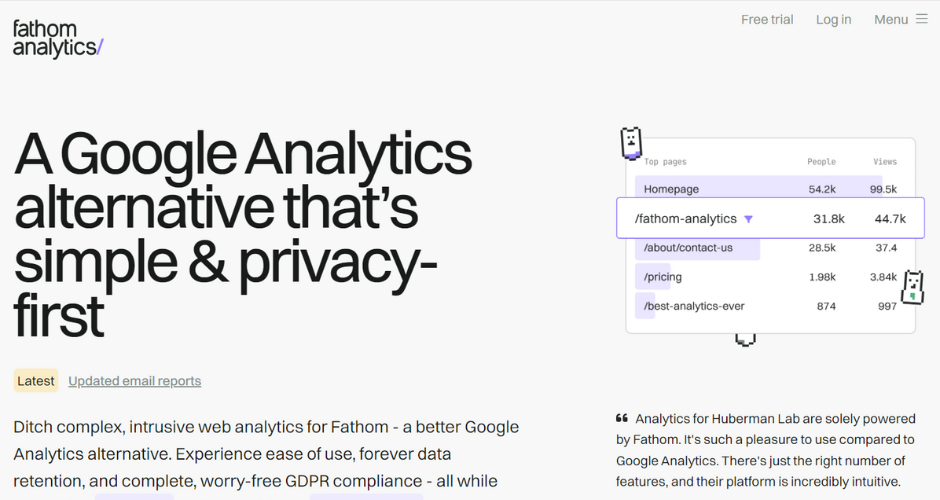
It boasts beautiful, intuitive dashboards that showcase key website metrics like page views, visitor sources, and engagement. Plus, its lightweight code ensures minimal impact on website loading times.
Fathom offers a free plan with basic features, perfect for small businesses. Paid plans start at a budget-friendly $14/month, scaling with increasing website traffic.
Google launched Meridian, a free, open-source tool that tracks ad performance across channels.
This new offering surpasses their prior marketing mix modelling option, LightweightMMM, by providing more advanced features.
Meridian analyses how all your marketing efforts, like ads, impact sales and other goals.
It lets you plan your media spending across channels more effectively. Google will also add its own data to the mix, including reach and frequency info from YouTube and search query volume.
While not yet available to everyone, Google plans to open it up soon.
Jentis caters to enterprises with stringent privacy requirements. This robust platform offers a high degree of customisation and control over user data collection.
Jentis goes beyond website tracking, integrating with CRMs and marketing automation tools for a holistic customer view.
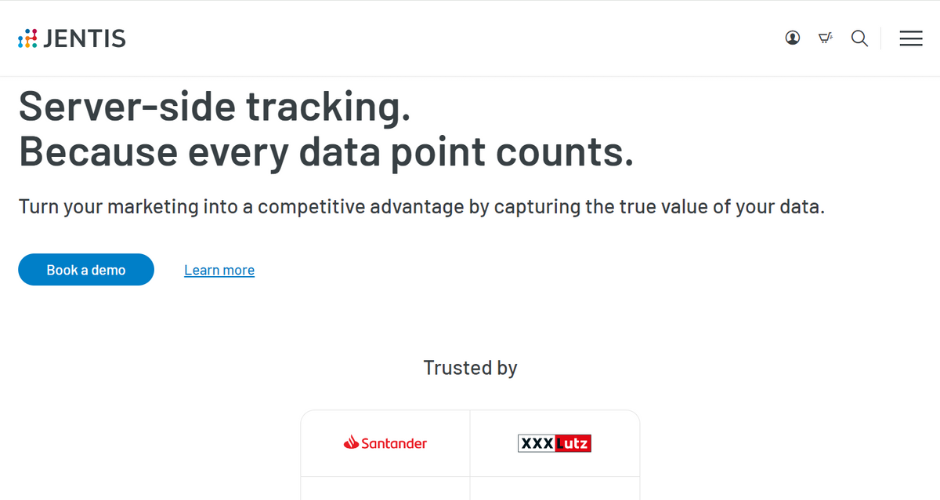
Jentis offers custom pricing plans based on specific needs. Expect a higher price point compared to other solutions on this list, reflecting its advanced features and enterprise focus.
Magic Pixel takes a server-side approach to cookieless tracking.
It collects data on your server, giving you complete control over what information is stored and for how long.
Magic Pixel offers flexibility and integrates with various analytics platforms, allowing you to tailor your tracking setup to your specific needs.
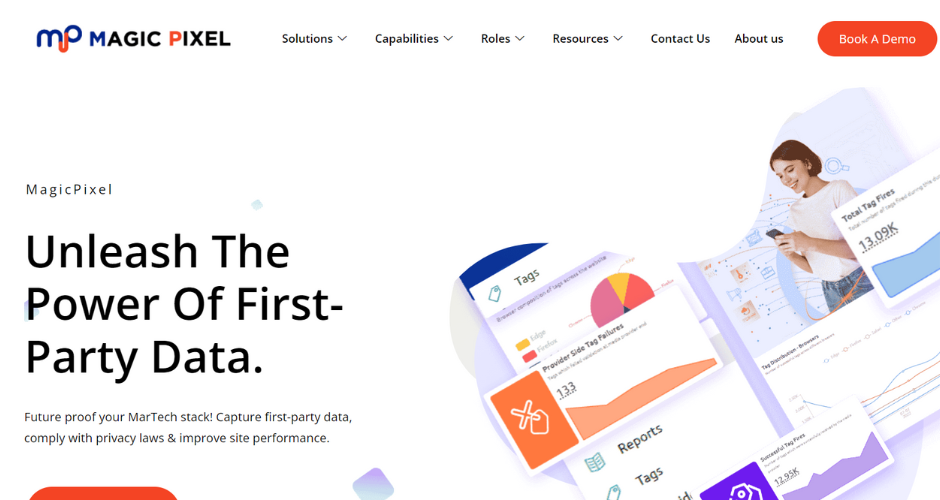
Magic Pixel offers a free plan with limited features. Paid plans start at a reasonable $29/month, providing access to more data points and integrations.
Meta’s Robyn helps advertisers optimise marketing campaigns. This open-source tool uses machine learning to analyse complex datasets and identify the most effective advertising channels.
Robyn is designed for businesses with rich data, particularly digital and direct response advertisers. It automates some tasks and provides insights into ad effectiveness over time.
Meta released Robyn as an open-source library, which means it’s free for anyone to use.
Simple Analytics lives up to its name. This streamlined tool focuses on core website analytics, providing valuable insights without overwhelming complexity.
It tracks essential metrics like page views, visitor sources, and referrals, presented in clear, actionable reports. Simple Analytics is ideal for businesses that prioritise a straightforward approach to website tracking.
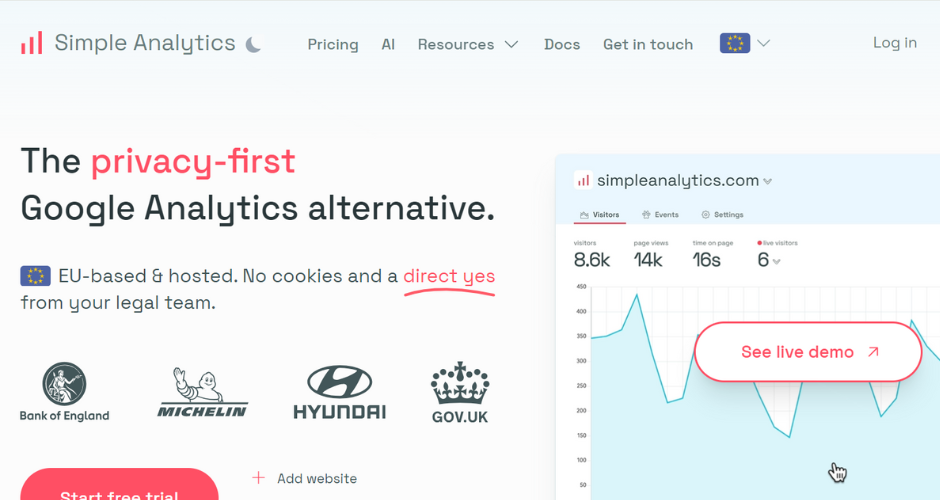
Simple Analytics offers a generous free plan with a 30-day data retention limit. Paid plans start at a very reasonable $11/month for longer data storage and advanced features.
Twipla goes beyond basic analytics, offering powerful conversion tracking features.
It helps you pinpoint exactly where visitors drop off in your conversion funnel, allowing you to identify and rectify roadblocks.
Twipla also provides heatmaps and session recordings, giving you a visual understanding of user behaviour.
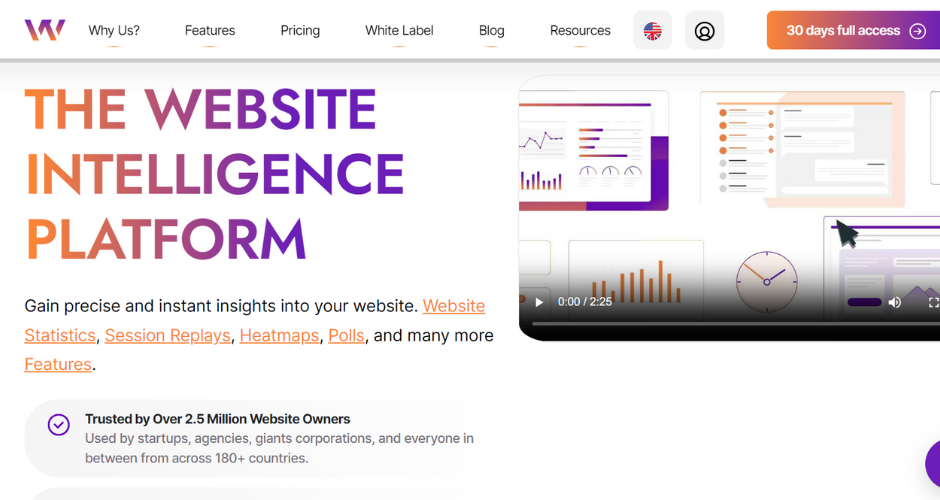
Twipla offers a free plan with limited features. Paid plans start at a competitive €49 (approx $53)/month, unlocking advanced conversion tracking tools and heatmaps.
As browser restrictions tighten, regulations strengthen, and privacy-conscious users reject cookies and block ads, the need for cookieless tracking solutions is undeniable.
Here at Ruler, we understand this evolving landscape.
Our innovative probabilistic tracking and MMM features provide valuable insights into user behaviour and marketing effectiveness without relying on cookies.
Don’t be left in the dark.
See how Ruler can empower your marketing efforts in the face of declining cookie reliability. Book a free demo today and discover the power of privacy-first marketing measurement.
